
Decorative Concrete
Something for Every Taste and Budget
by Kathy Danforth/Published April 2014
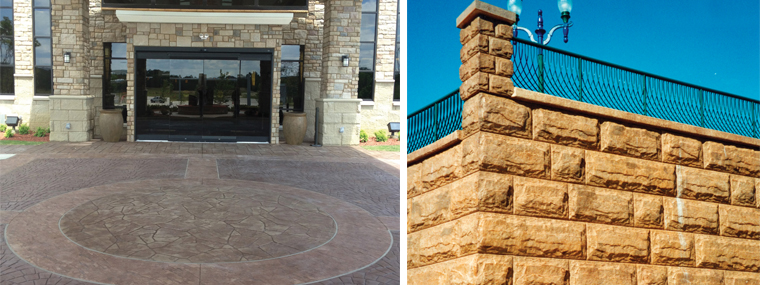
When it comes to appearance, concrete is a more flexible material than city sidewalks might lead one to believe. “The start of decorative concrete was really back in the 1930s and ‘40s in Hollywood, when they would create a scene rather than traveling to a distant location,” says Rich Cofoid with Increte Systems. “Disneyland used decorative and stamped concrete in the 1950s, and it spread to resorts and hotels. Now, because of the high cost of natural materials, it is used in many more applications.
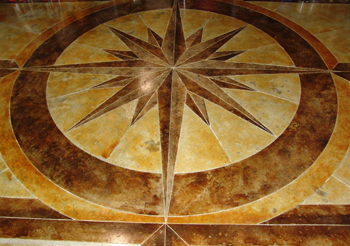 “The modern era of decorative concrete began in the 1950s when John Bowman patented Bowmanite,” Cofoid explains. “The concrete was integrally colored with pigment and was imprinted with an open shape like a cookie cutter. Now that we have release agents, the stamping tools are made of urethane rubber that enables us to imprint texture as well as shape.”
“The modern era of decorative concrete began in the 1950s when John Bowman patented Bowmanite,” Cofoid explains. “The concrete was integrally colored with pigment and was imprinted with an open shape like a cookie cutter. Now that we have release agents, the stamping tools are made of urethane rubber that enables us to imprint texture as well as shape.”
Decorative concrete that is cast in place is foremost a concrete job, according to Cofoid. “The sub-base preparation, mixing, and pouring are the same as for a flat pour; the contractor just colors the mix and imprints the pattern while it is still wet. Vertical forms can also be poured in place or pre-cast into designed panels and set between beams.”
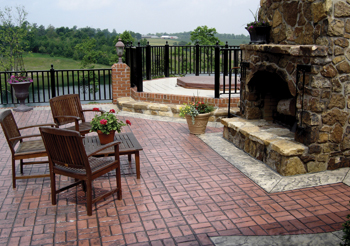 Stamping and/or coloring can be applied anywhere concrete is being poured. “This method is used frequently for pool decks, patios, driveways, parking lots, and entrances to subdivisions,” according to Cofoid. “A subdivision often uses stamped concrete to set their entrance apart—and it can also serve as a rumble strip to slow down traffic. In several subdivisions, every driveway has a stamped concrete pattern. A stamped concrete design is also commonly used to enhance a retaining wall or seawall.”
Stamping and/or coloring can be applied anywhere concrete is being poured. “This method is used frequently for pool decks, patios, driveways, parking lots, and entrances to subdivisions,” according to Cofoid. “A subdivision often uses stamped concrete to set their entrance apart—and it can also serve as a rumble strip to slow down traffic. In several subdivisions, every driveway has a stamped concrete pattern. A stamped concrete design is also commonly used to enhance a retaining wall or seawall.”
When concrete is already in place, it is not too late to change the décor without replacing the concrete. “If the concrete is structurally sound, there are several types of cementitious overlays to achieve a new look,” Cofoid notes. “A stamped overlay can be poured to one-quarter to one-half inch thickness over a current slab. With an overlay, the contractor has to honor the underlying control joints or saw cuts, since concrete expands and contracts with temperature. A good contractor will tell the customer that they can’t guarantee that all underlying cracks can be repaired, since some may show back up through the overlay.
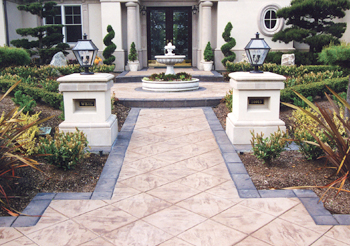 “Spray-down, knock-down coatings consist of cementitious grout with a polymer. This Portland cement product is sprayed or troweled in a very thin layer. When it cures, it has a strength of 4000–6000 psi, while concrete has an average strength of 3000 psi. Since it is sealed, it is impervious to moisture and resists mildew and stains. This surface can be colored and is highly textured so it’s great for entrance walkways and pool decks,” Cofoid notes. “Many people are familiar with cool deck, a sand and cement mixture, which is stippled with a brush, but that doesn’t wear as well as these coatings because it only contains sand and cement.
“Spray-down, knock-down coatings consist of cementitious grout with a polymer. This Portland cement product is sprayed or troweled in a very thin layer. When it cures, it has a strength of 4000–6000 psi, while concrete has an average strength of 3000 psi. Since it is sealed, it is impervious to moisture and resists mildew and stains. This surface can be colored and is highly textured so it’s great for entrance walkways and pool decks,” Cofoid notes. “Many people are familiar with cool deck, a sand and cement mixture, which is stippled with a brush, but that doesn’t wear as well as these coatings because it only contains sand and cement.
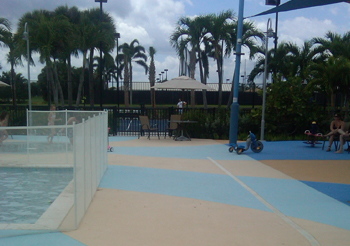 “Microtoppings are an even thinner overlay for concrete and are typically used if someone is going to stain the concrete,” Cofoid relates. “When concrete, whether interior or exterior, is stained, it is a finished surface—the final look. A microtopping is used when the concrete is good structurally but the surface is not in adequate shape. Outside concrete might have some pitting or spalling, and inside concrete might have had tiles or carpet glued down that can’t be totally cleaned. Since concrete is porous, when you stain it, inconsistencies such as these are really highlighted, so the microtopping provides a fresh base to apply stain to.
“Microtoppings are an even thinner overlay for concrete and are typically used if someone is going to stain the concrete,” Cofoid relates. “When concrete, whether interior or exterior, is stained, it is a finished surface—the final look. A microtopping is used when the concrete is good structurally but the surface is not in adequate shape. Outside concrete might have some pitting or spalling, and inside concrete might have had tiles or carpet glued down that can’t be totally cleaned. Since concrete is porous, when you stain it, inconsistencies such as these are really highlighted, so the microtopping provides a fresh base to apply stain to.
“Typically for an interior application, the microtopping will be self-leveling to give a nice, smooth finish. For exterior applications, you want texture to avoid slip-and-fall injuries, so the material is broomable and will hold texture,” Cofoid explains. “You can integrally color the microtopping and put a sealer on it, or you can apply stain to the microtopping.”
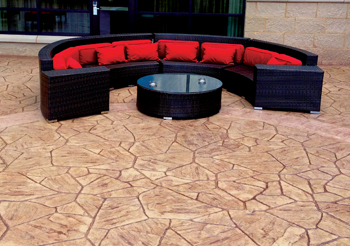 Concrete stains can produce an appearance ranging from natural, quarried stone to a vivid, high-sheen, solid color. “Chemical stain, also referred to as acid stain, comes in 6–10 natural shades and reacts with the concrete similarly to how wood stain reacts with wood,” according to Cofoid. “The metallic salts in the stain soak in and become part of the top layer.
Concrete stains can produce an appearance ranging from natural, quarried stone to a vivid, high-sheen, solid color. “Chemical stain, also referred to as acid stain, comes in 6–10 natural shades and reacts with the concrete similarly to how wood stain reacts with wood,” according to Cofoid. “The metallic salts in the stain soak in and become part of the top layer.
“Semi-transparent, water-based stains are similar to acid stain, but they are available in more colors so reds, blues, and grays are available,” states Cofoid. “Solid color acrylics are not transparent and resemble traditional paint. They are also known as a stain sealer because they penetrate and seal the concrete so it is impervious to moisture, which is useful for pool decks.”
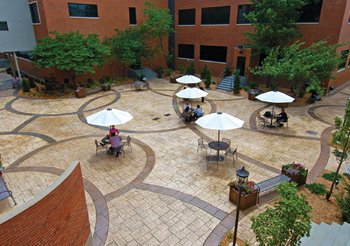 Dyes that create bright hues are produced for interior use and are typically used on polished concrete. The result is similar to terrazzo tile and can be polished to a medium or high-gloss shine, which makes it slick when wet and unsuited for outdoor use. “Polished concrete floors can be seen in several of the big box stores, where they are polished to a medium shine. They are common in hallways, foyers, and interior entrances because they are extremely low maintenance; the more they are walked on, the more polished they become,” Cofoid observes.
Dyes that create bright hues are produced for interior use and are typically used on polished concrete. The result is similar to terrazzo tile and can be polished to a medium or high-gloss shine, which makes it slick when wet and unsuited for outdoor use. “Polished concrete floors can be seen in several of the big box stores, where they are polished to a medium shine. They are common in hallways, foyers, and interior entrances because they are extremely low maintenance; the more they are walked on, the more polished they become,” Cofoid observes.
“Interior, polished concrete is also an eco-friendly option,” Cofoid notes, “and is the rage in LEED (Leader-ship in Energy and Environ-mental Design) certification for new and renovated buildings. Since the concrete is already in place, no new flooring material is used or shipped. Maintenance is minimal, and the high-gloss surface can also help cut down on the lighting required.”
Another option for interior concrete is resinous overlays or coatings. “These high-performance, interior flooring options are epoxy-based systems that are 100 percent solids, which makes them highly chemical-resistant. Most types are FDA-com-pliant, making them suitable for food preparation areas, parking garages, locker rooms, showers, and garages, etc. These materials are typically not UV-resistant, so they are not for exterior use,” Cofoid acknowledges.
“With the stains and dyes, there are some true artists out there,” Cofoid shares. “They are creating some amazing work with stencils and freehand murals on the floor. Some are pushing the boundaries with stamped and cementitious overlays and can give you floors that look 3D—you have some of the decorative options you might have considered only for a wall.
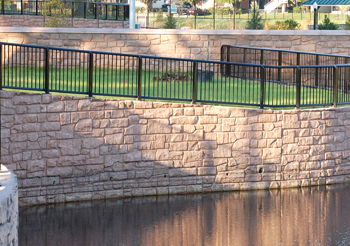 “Decorative concrete can bring more bang for the buck and set a property apart from its competitors,” Cofoid advises. “Stamped concrete typically runs $7–$10 per square foot (sf) and can achieve the same look as natural slate or flagstone, which may cost $30–$50 per sf. The cost of staining interior or exterior concrete varies greatly depending on the preparation required,” says Cofoid. “For a fairly clean surface, application can run $2.50–$4.00, with up to $2 per sf for surface preparation if needed and another $2 per sf if a microtopping is required. That means getting a look like natural material for $3–$10 per sf.
“Decorative concrete can bring more bang for the buck and set a property apart from its competitors,” Cofoid advises. “Stamped concrete typically runs $7–$10 per square foot (sf) and can achieve the same look as natural slate or flagstone, which may cost $30–$50 per sf. The cost of staining interior or exterior concrete varies greatly depending on the preparation required,” says Cofoid. “For a fairly clean surface, application can run $2.50–$4.00, with up to $2 per sf for surface preparation if needed and another $2 per sf if a microtopping is required. That means getting a look like natural material for $3–$10 per sf.
“Curb appeal is a prime concern for properties,” Cofoid notes. “Deco-rative concrete can enable a striking difference for entryways, pool decks and patios, and balconies and lanais. At the front entrance of a subdivision, a slate, stone, or brick look is awesome. A pool deck can look like natural wood without worrying about it rotting out. If you have balconies and a leak has developed where the concrete meets the wall, a waterproofing membrane can be installed with a decorative, cementitious overlay.”
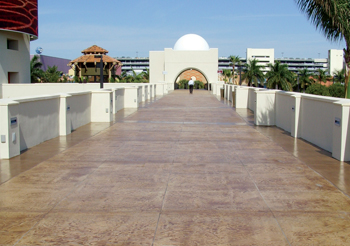 Compared to other materials, maintenance for decorative concrete is minimal and consists primarily of keeping it sealed. “The sealer is your sacrificial surface, like wax on a car,” Cofoid points out. “Usually there are two coats of sealer on stamped concrete, stamped overlay, or sprayed coating. Foot traffic is the most abusive environment because people scrape their feet with sand and rocks in the shoe soles. Resealing may be required every one to five years, but if there is not resealing, the concrete will develop an aged appearance. Old Town in Kissimmee has stamped concrete resembling brick that has not been resealed since it was installed in the mid-1980s, and it has a worn, turn-of-the century look. Pavers are frequently an alternative to concrete, but they have more limited shapes and colors and present a shifting substrate that can get weeds, mold, mildew, stains, and fade more easily than a solid slab of concrete.”
Compared to other materials, maintenance for decorative concrete is minimal and consists primarily of keeping it sealed. “The sealer is your sacrificial surface, like wax on a car,” Cofoid points out. “Usually there are two coats of sealer on stamped concrete, stamped overlay, or sprayed coating. Foot traffic is the most abusive environment because people scrape their feet with sand and rocks in the shoe soles. Resealing may be required every one to five years, but if there is not resealing, the concrete will develop an aged appearance. Old Town in Kissimmee has stamped concrete resembling brick that has not been resealed since it was installed in the mid-1980s, and it has a worn, turn-of-the century look. Pavers are frequently an alternative to concrete, but they have more limited shapes and colors and present a shifting substrate that can get weeds, mold, mildew, stains, and fade more easily than a solid slab of concrete.”
In choosing a stamped concrete pattern, Cofoid advises attention to texture. “There are more than 100 patterns and textures, ranging from very smooth to high relief. If it is quite smooth, it is well suited for walking areas and outdoor furniture, but too much relief can catch a high heel.
“Using a qualified contractor who pays attention to detail is key to a good job,” Cofoid states. “At a minimum, he should have certification from the American Society of Concrete Contractors. In some counties, a contractor’s license is required for concrete work or spray-down, knock-down overlay applications. There are a lot of fly-by-night contractors in a pick-up, and if you choose that lowball price, you’re likely to get a lowball result. You need to check references and experience with the particular type and scope of project you are considering.
“If you hire the right contractor, they should educate the board about the project. Even just a stain typically takes several days to complete because it takes a day for preparation, a day to stain, a day to scrub residue, and another to apply sealer. We suggest no traffic for a day after the sealer is put down. Stamped concrete can take several days to a week, with no driving for 72 hours on roadways if possible. That may require one side of the roadway to be done at a time.
“Because of the variety of options, both interior and exterior, there’s something for every taste and budget,” Cofoid remarks. “If you want the look of a yellow brick road or a flagstone terrace without the exotic price, decorative concrete may be the path to follow.”

